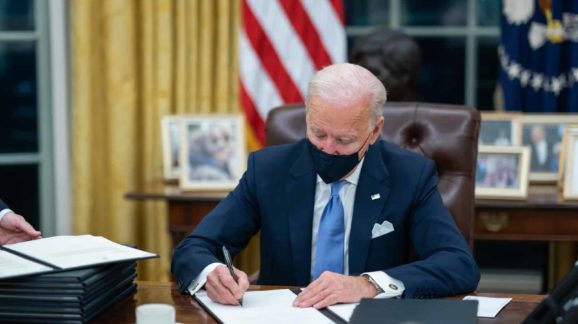The Growth-By-Deregulation Alternative To Joe Biden’s Cyclopean American Jobs Plan
Sandwiched between Joe Biden’s $1.9 American Rescue Plan and a promised American Families Plan is the American Jobs Plan (AJP), the ambitious $2.2 trillion infrastructure package making so much news.
We want to make goods and services in the U.S. and create high-paying jobs and prosperity. But what really is the national government’s role in fostering these plus robust infrastructure? Caution: For every action, there is an equal-and-opposite government program.
Amid ample favorable media coverage, critics have questioned some AJP premises. Among these: that it will “create millions” of “good-paying jobs”; that federal spending constitutes “investment” (let alone “ovedue” investment); that federal spending is preferable to others’ spending or investing the same dollars; and that the AJP and Biden will “reduce deficits” 16 years from now.
And never quite clarified is how $28 trillion in federal debt is not stimulus enough, already.
Most noted has been the rebranding of social spending as infrastructure. But Biden is not hiding that much of what he calls infrastructure is instead further down payment on a government-centric “caregiving economy” encompassing childhood to old age. Elements include $400 billion for expanding elderly and disabled long-term care through Medicaid, and “affordable housing.” Even the Associated Press noted the “rhetorical gymnastics” entailed in the rebranding. In merely two months Biden has easily eclipsed Obama’s State of the Union calls for free community college and enlarged paid work leave, seen as transformative in their time.
On the bits of the AJP that do constitute old-school infrastructure, working in Biden’s favor is bipartisan consensus that government can spearhead frontier areas. In his March 31 Pittsburgh speech announcing the AJP, Biden cited battery technology, biotechnology, computer chips and clean energy as targets for spending.
But if capitalism is vital to wealth creation at small and medium scales, it is even more important at grand scales in a modern technological society. If the central government is in fact not the wellspring of prosperity, that has major implications for what a genuine infrastructure package would entail and changes our entire conversation.
A clue that the model is wrong and a course correction is in order may be found in Biden’s very arguments for the AJP.Biden wants to “rebuild the backbone of America” But why would something be wrong with America’s backbone? It cannot be that government is smaller than it used to be.
Biden’s AJP description says, “After decades of disinvestment, our roads, bridges, and water systems are crumbling. Our electric grid is vulnerable to catastrophic outages.” But why would any of this crumble? We don’t periodically lament “disinvestment” in big box stores, tech companies, fast food restaurants, Sheetz road stops and gas stations, and fret that these all are “crumbling.” Those are infrastructure too; certainly moreso than much of what is in Biden’s plan, and they keep growing. Like Jay Leno used to say in the old Doritos commercials, “Crunch all you want. We’ll make more.”
Biden talks of “modernization” of infrastructure, but a real modernization would entail cutting government’s longstanding dominance (and subsequent neglect) of it. Unlike ongoing private investment, enthusiasm subsides after the ribbon-cutting at big-government projects. Biden’s is a quest destined to deliver tomorrow’s equivalents of yesterday’s ill-fated and leap-frogged National Road, C&O Canal, and appropriation-plagued Superconducting Super Collider. Those are nothing compared to the Lovecraftian desolation to come should Biden get his misguided way.
Other entities in society create big-wealth better than Washington does, and there is a vast supply of money for it if government and its permitting mazes get out of the way. Alas, the New New Deal Biden is pursuing via his legislative triad isnothing new despite the emphasis on “upgrade” and “modernization.” In the 21st Century, getting clean, fresh water piped into a home is not a mystery-laden undertaking, nor something to occupy a national government. Keeping things local and leaving money in the states in the first place can better prevent the “crumbling” and “disinvestment.”
A superior posture from which to boost infrastructure would be that of a concerted effort to separate state and economics, and to expel the policies of radical progressivism. To set the stage for that, it helps to appreciate how we got where we are.
Attempts were made at major central government undertakings in America’s early years, particularly for “internal improvements,” protective tariffs, and a central bank. Alexander Hamilton’s mercantilist Report on Manufactures encouraged industry subsidies and tariffs, paving the way for Kentucky’s Sen. Henry Clay and his American System of subsidies for roads and canals and other internal improvements, a national bank, and tariffs (vetoed by presidents Madison and Monroe). Thoroughgoing centralization had to await Lincoln and his embrace of the Clay approach, war mobilization, and constitutional reinterpretations that enabled massive national government expansion.
Statutes passed since the late 19th century expanded executive power and changed the relationship of the individual to the state. The Interstate Commerce Act arrived a century after the Constitution, followed by the Sherman and Clayton antitrust Acts, a permanent central bank immune from audit and a progressive federal income tax and later mandatory withholding.
Read the full article at Forbes.
